Role of Nurses in the Management of Depression and Suicide: Analysis
VerifiedAdded on 2020/03/13
|12
|3147
|58
Report
AI Summary
This report delves into the critical role of nurses in managing depression and suicide, examining the prevalence of these conditions, particularly in Australia. It analyzes the impact of various factors, such as bereavement, socioeconomic status, and relationship issues, on mental health, using a case study to illustrate these points. The report emphasizes the importance of ethical principles like nonmaleficence and beneficence in nursing practice, alongside the legal framework provided by the Mental Health Act. It outlines specific nursing interventions for suicidal behavior, hopelessness, and depression, highlighting the rationale and expected outcomes of each approach. The interventions include crisis management, promoting patient safety, encouraging social interaction, and fostering a sense of hope and well-being. The report underscores the need for nurses to provide comprehensive care, address psychological needs, and promote patient coping abilities to effectively manage depression and prevent suicide.
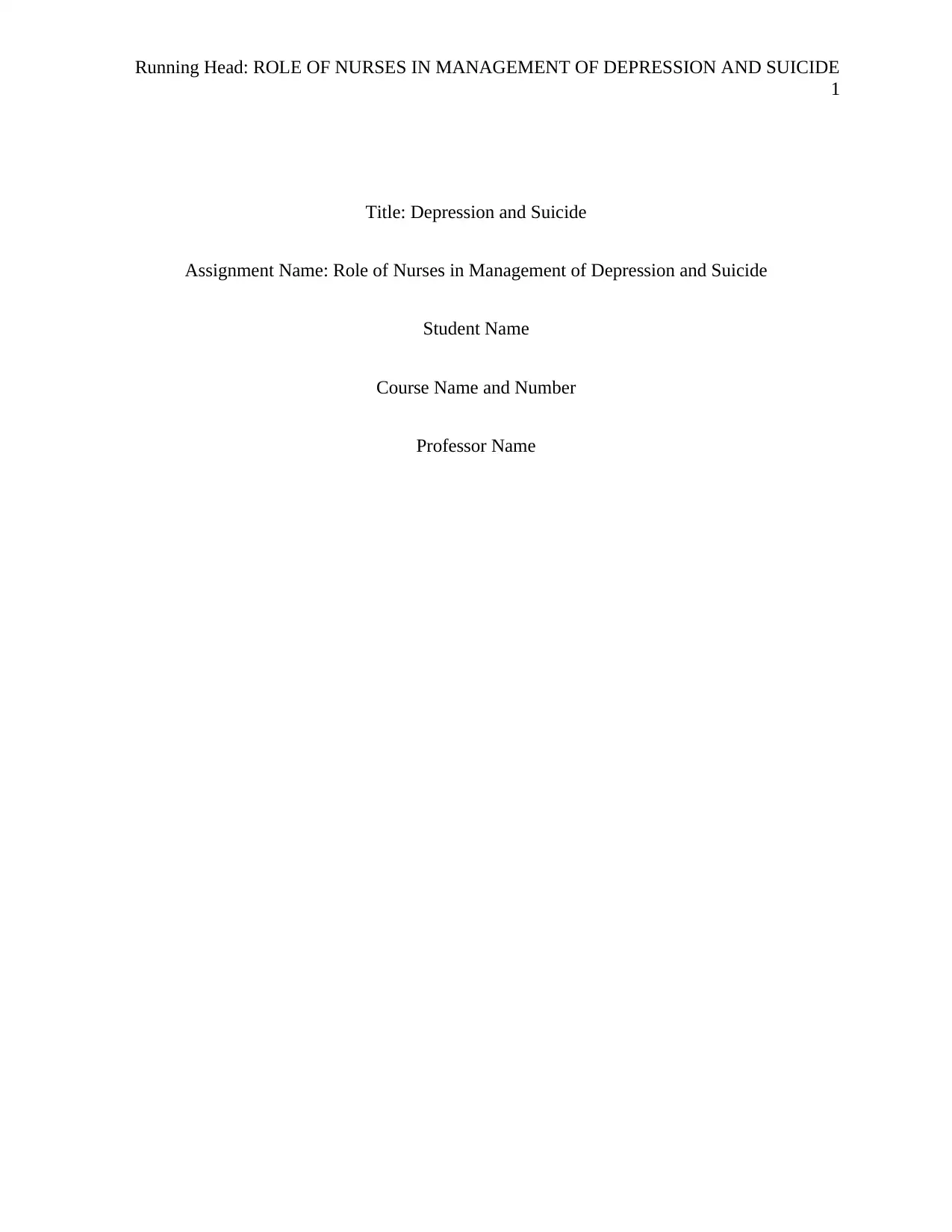
Running Head: ROLE OF NURSES IN MANAGEMENT OF DEPRESSION AND SUICIDE
1
Title: Depression and Suicide
Assignment Name: Role of Nurses in Management of Depression and Suicide
Student Name
Course Name and Number
Professor Name
1
Title: Depression and Suicide
Assignment Name: Role of Nurses in Management of Depression and Suicide
Student Name
Course Name and Number
Professor Name
Paraphrase This Document
Need a fresh take? Get an instant paraphrase of this document with our AI Paraphraser
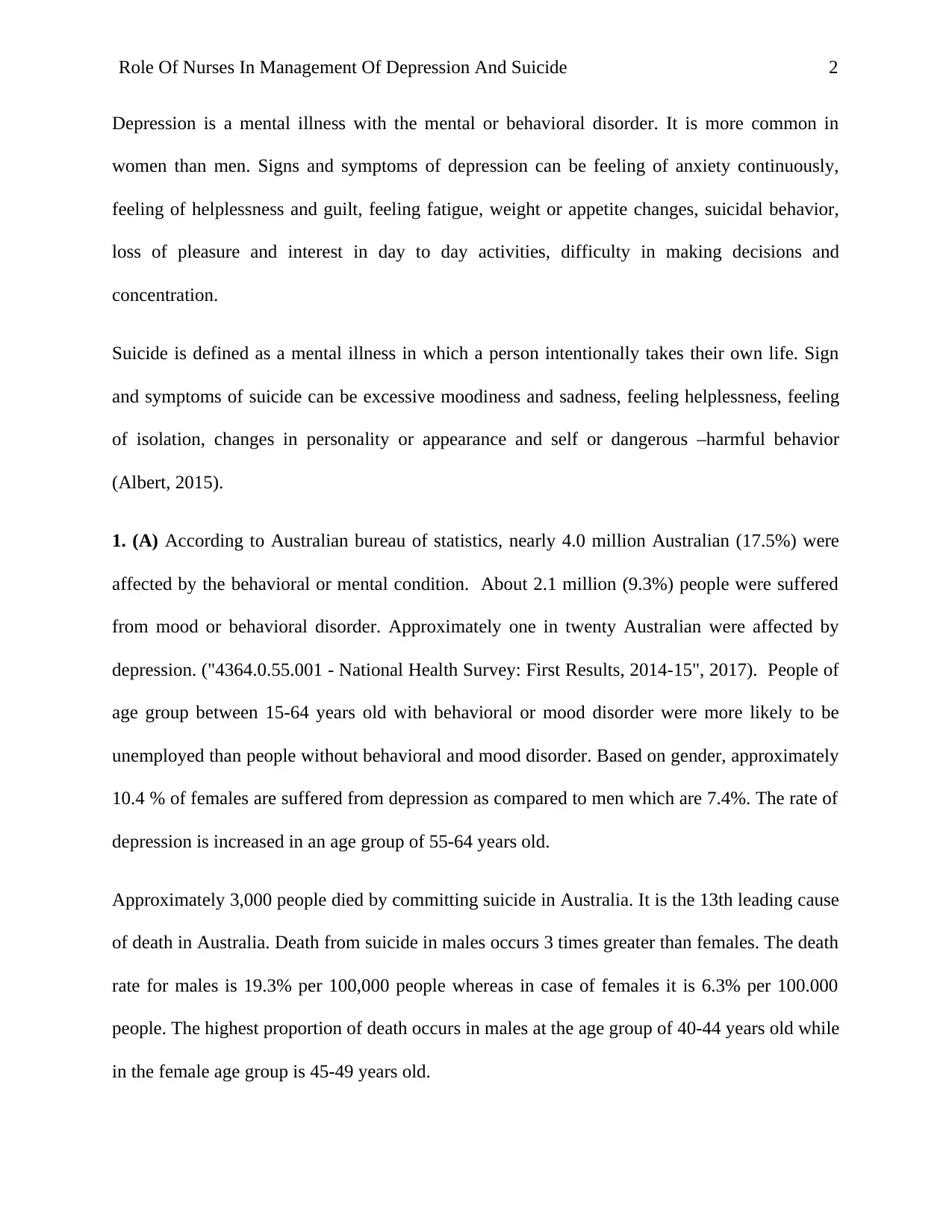
Role Of Nurses In Management Of Depression And Suicide 2
Depression is a mental illness with the mental or behavioral disorder. It is more common in
women than men. Signs and symptoms of depression can be feeling of anxiety continuously,
feeling of helplessness and guilt, feeling fatigue, weight or appetite changes, suicidal behavior,
loss of pleasure and interest in day to day activities, difficulty in making decisions and
concentration.
Suicide is defined as a mental illness in which a person intentionally takes their own life. Sign
and symptoms of suicide can be excessive moodiness and sadness, feeling helplessness, feeling
of isolation, changes in personality or appearance and self or dangerous –harmful behavior
(Albert, 2015).
1. (A) According to Australian bureau of statistics, nearly 4.0 million Australian (17.5%) were
affected by the behavioral or mental condition. About 2.1 million (9.3%) people were suffered
from mood or behavioral disorder. Approximately one in twenty Australian were affected by
depression. ("4364.0.55.001 - National Health Survey: First Results, 2014-15", 2017). People of
age group between 15-64 years old with behavioral or mood disorder were more likely to be
unemployed than people without behavioral and mood disorder. Based on gender, approximately
10.4 % of females are suffered from depression as compared to men which are 7.4%. The rate of
depression is increased in an age group of 55-64 years old.
Approximately 3,000 people died by committing suicide in Australia. It is the 13th leading cause
of death in Australia. Death from suicide in males occurs 3 times greater than females. The death
rate for males is 19.3% per 100,000 people whereas in case of females it is 6.3% per 100.000
people. The highest proportion of death occurs in males at the age group of 40-44 years old while
in the female age group is 45-49 years old.
Depression is a mental illness with the mental or behavioral disorder. It is more common in
women than men. Signs and symptoms of depression can be feeling of anxiety continuously,
feeling of helplessness and guilt, feeling fatigue, weight or appetite changes, suicidal behavior,
loss of pleasure and interest in day to day activities, difficulty in making decisions and
concentration.
Suicide is defined as a mental illness in which a person intentionally takes their own life. Sign
and symptoms of suicide can be excessive moodiness and sadness, feeling helplessness, feeling
of isolation, changes in personality or appearance and self or dangerous –harmful behavior
(Albert, 2015).
1. (A) According to Australian bureau of statistics, nearly 4.0 million Australian (17.5%) were
affected by the behavioral or mental condition. About 2.1 million (9.3%) people were suffered
from mood or behavioral disorder. Approximately one in twenty Australian were affected by
depression. ("4364.0.55.001 - National Health Survey: First Results, 2014-15", 2017). People of
age group between 15-64 years old with behavioral or mood disorder were more likely to be
unemployed than people without behavioral and mood disorder. Based on gender, approximately
10.4 % of females are suffered from depression as compared to men which are 7.4%. The rate of
depression is increased in an age group of 55-64 years old.
Approximately 3,000 people died by committing suicide in Australia. It is the 13th leading cause
of death in Australia. Death from suicide in males occurs 3 times greater than females. The death
rate for males is 19.3% per 100,000 people whereas in case of females it is 6.3% per 100.000
people. The highest proportion of death occurs in males at the age group of 40-44 years old while
in the female age group is 45-49 years old.
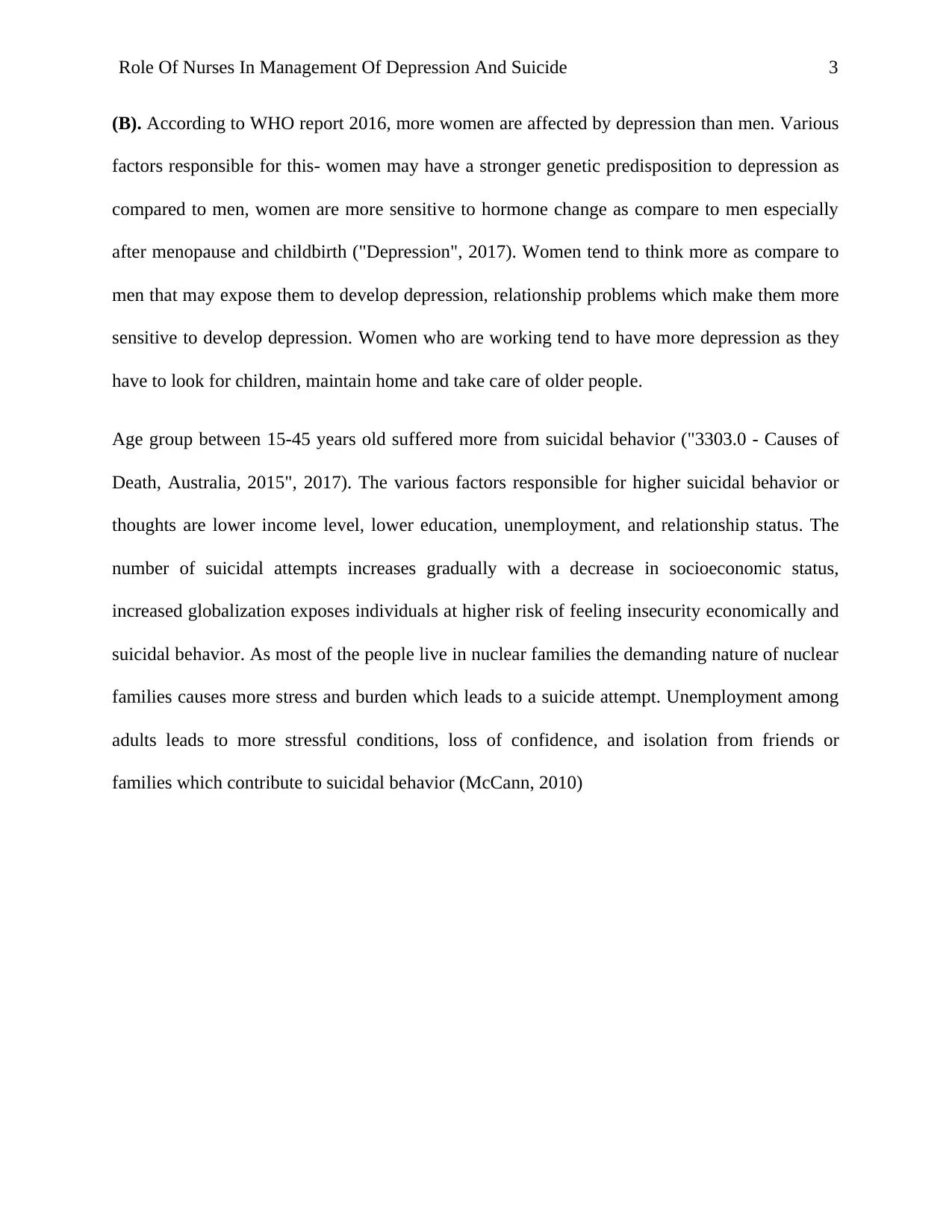
Role Of Nurses In Management Of Depression And Suicide 3
(B). According to WHO report 2016, more women are affected by depression than men. Various
factors responsible for this- women may have a stronger genetic predisposition to depression as
compared to men, women are more sensitive to hormone change as compare to men especially
after menopause and childbirth ("Depression", 2017). Women tend to think more as compare to
men that may expose them to develop depression, relationship problems which make them more
sensitive to develop depression. Women who are working tend to have more depression as they
have to look for children, maintain home and take care of older people.
Age group between 15-45 years old suffered more from suicidal behavior ("3303.0 - Causes of
Death, Australia, 2015", 2017). The various factors responsible for higher suicidal behavior or
thoughts are lower income level, lower education, unemployment, and relationship status. The
number of suicidal attempts increases gradually with a decrease in socioeconomic status,
increased globalization exposes individuals at higher risk of feeling insecurity economically and
suicidal behavior. As most of the people live in nuclear families the demanding nature of nuclear
families causes more stress and burden which leads to a suicide attempt. Unemployment among
adults leads to more stressful conditions, loss of confidence, and isolation from friends or
families which contribute to suicidal behavior (McCann, 2010)
(B). According to WHO report 2016, more women are affected by depression than men. Various
factors responsible for this- women may have a stronger genetic predisposition to depression as
compared to men, women are more sensitive to hormone change as compare to men especially
after menopause and childbirth ("Depression", 2017). Women tend to think more as compare to
men that may expose them to develop depression, relationship problems which make them more
sensitive to develop depression. Women who are working tend to have more depression as they
have to look for children, maintain home and take care of older people.
Age group between 15-45 years old suffered more from suicidal behavior ("3303.0 - Causes of
Death, Australia, 2015", 2017). The various factors responsible for higher suicidal behavior or
thoughts are lower income level, lower education, unemployment, and relationship status. The
number of suicidal attempts increases gradually with a decrease in socioeconomic status,
increased globalization exposes individuals at higher risk of feeling insecurity economically and
suicidal behavior. As most of the people live in nuclear families the demanding nature of nuclear
families causes more stress and burden which leads to a suicide attempt. Unemployment among
adults leads to more stressful conditions, loss of confidence, and isolation from friends or
families which contribute to suicidal behavior (McCann, 2010)
⊘ This is a preview!⊘
Do you want full access?
Subscribe today to unlock all pages.

Trusted by 1+ million students worldwide
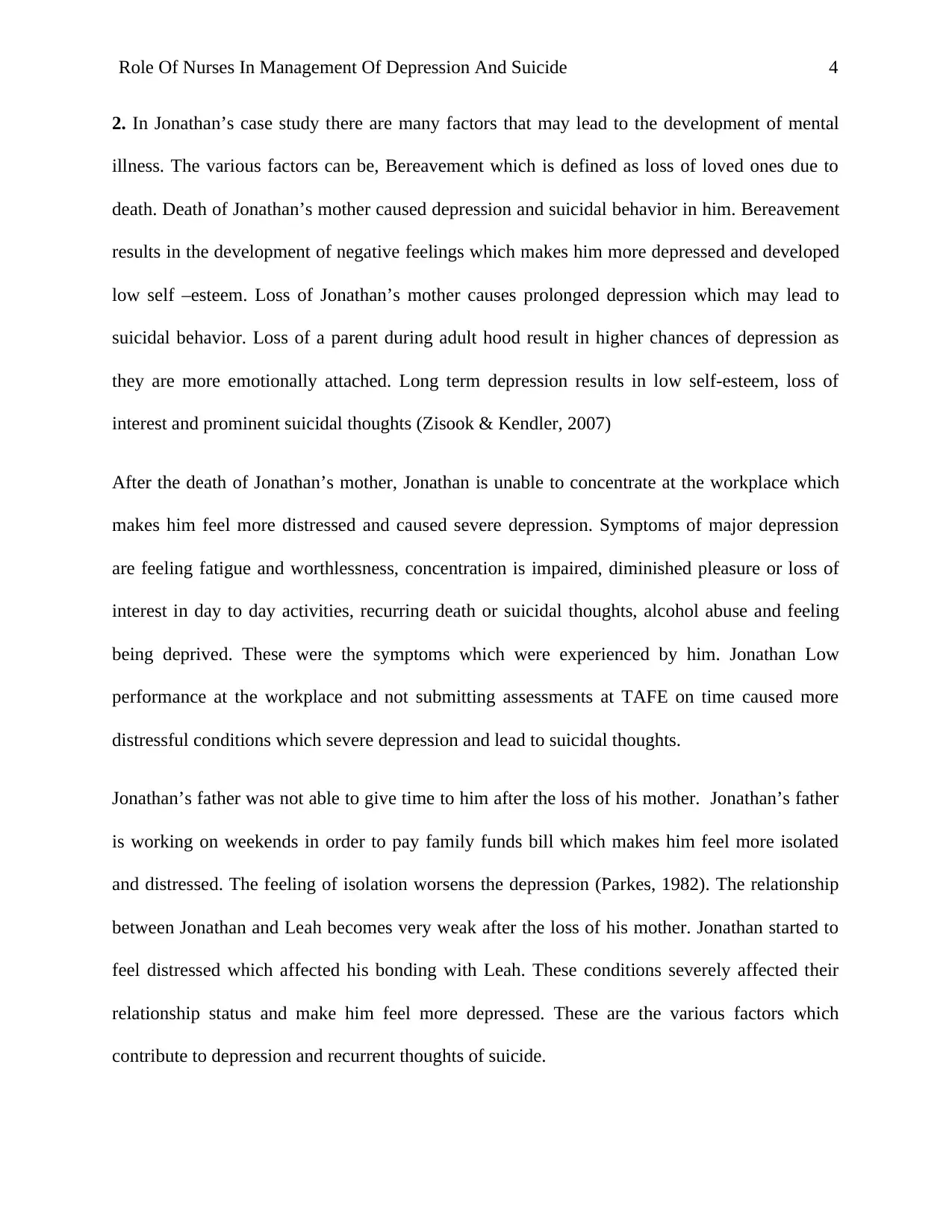
Role Of Nurses In Management Of Depression And Suicide 4
2. In Jonathan’s case study there are many factors that may lead to the development of mental
illness. The various factors can be, Bereavement which is defined as loss of loved ones due to
death. Death of Jonathan’s mother caused depression and suicidal behavior in him. Bereavement
results in the development of negative feelings which makes him more depressed and developed
low self –esteem. Loss of Jonathan’s mother causes prolonged depression which may lead to
suicidal behavior. Loss of a parent during adult hood result in higher chances of depression as
they are more emotionally attached. Long term depression results in low self-esteem, loss of
interest and prominent suicidal thoughts (Zisook & Kendler, 2007)
After the death of Jonathan’s mother, Jonathan is unable to concentrate at the workplace which
makes him feel more distressed and caused severe depression. Symptoms of major depression
are feeling fatigue and worthlessness, concentration is impaired, diminished pleasure or loss of
interest in day to day activities, recurring death or suicidal thoughts, alcohol abuse and feeling
being deprived. These were the symptoms which were experienced by him. Jonathan Low
performance at the workplace and not submitting assessments at TAFE on time caused more
distressful conditions which severe depression and lead to suicidal thoughts.
Jonathan’s father was not able to give time to him after the loss of his mother. Jonathan’s father
is working on weekends in order to pay family funds bill which makes him feel more isolated
and distressed. The feeling of isolation worsens the depression (Parkes, 1982). The relationship
between Jonathan and Leah becomes very weak after the loss of his mother. Jonathan started to
feel distressed which affected his bonding with Leah. These conditions severely affected their
relationship status and make him feel more depressed. These are the various factors which
contribute to depression and recurrent thoughts of suicide.
2. In Jonathan’s case study there are many factors that may lead to the development of mental
illness. The various factors can be, Bereavement which is defined as loss of loved ones due to
death. Death of Jonathan’s mother caused depression and suicidal behavior in him. Bereavement
results in the development of negative feelings which makes him more depressed and developed
low self –esteem. Loss of Jonathan’s mother causes prolonged depression which may lead to
suicidal behavior. Loss of a parent during adult hood result in higher chances of depression as
they are more emotionally attached. Long term depression results in low self-esteem, loss of
interest and prominent suicidal thoughts (Zisook & Kendler, 2007)
After the death of Jonathan’s mother, Jonathan is unable to concentrate at the workplace which
makes him feel more distressed and caused severe depression. Symptoms of major depression
are feeling fatigue and worthlessness, concentration is impaired, diminished pleasure or loss of
interest in day to day activities, recurring death or suicidal thoughts, alcohol abuse and feeling
being deprived. These were the symptoms which were experienced by him. Jonathan Low
performance at the workplace and not submitting assessments at TAFE on time caused more
distressful conditions which severe depression and lead to suicidal thoughts.
Jonathan’s father was not able to give time to him after the loss of his mother. Jonathan’s father
is working on weekends in order to pay family funds bill which makes him feel more isolated
and distressed. The feeling of isolation worsens the depression (Parkes, 1982). The relationship
between Jonathan and Leah becomes very weak after the loss of his mother. Jonathan started to
feel distressed which affected his bonding with Leah. These conditions severely affected their
relationship status and make him feel more depressed. These are the various factors which
contribute to depression and recurrent thoughts of suicide.
Paraphrase This Document
Need a fresh take? Get an instant paraphrase of this document with our AI Paraphraser
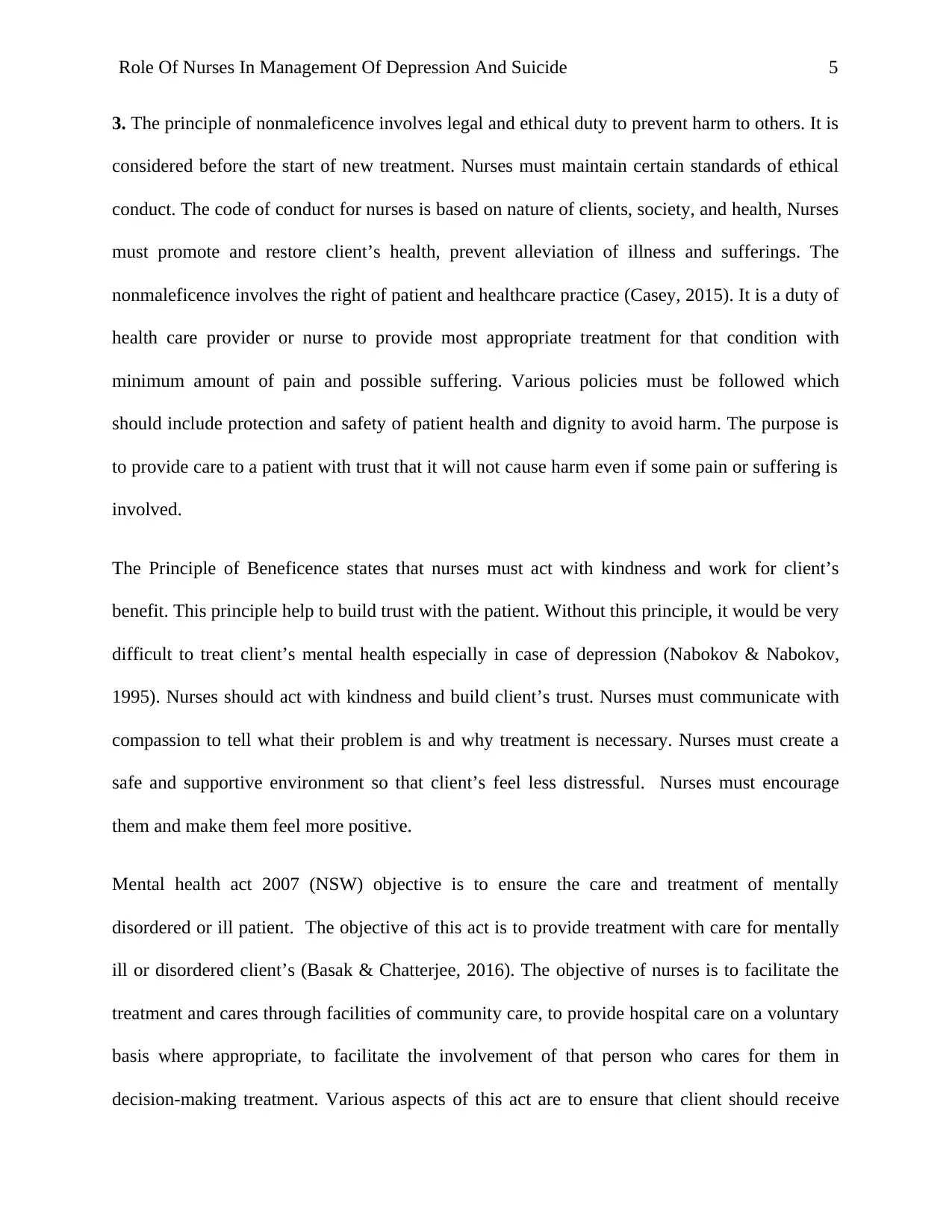
Role Of Nurses In Management Of Depression And Suicide 5
3. The principle of nonmaleficence involves legal and ethical duty to prevent harm to others. It is
considered before the start of new treatment. Nurses must maintain certain standards of ethical
conduct. The code of conduct for nurses is based on nature of clients, society, and health, Nurses
must promote and restore client’s health, prevent alleviation of illness and sufferings. The
nonmaleficence involves the right of patient and healthcare practice (Casey, 2015). It is a duty of
health care provider or nurse to provide most appropriate treatment for that condition with
minimum amount of pain and possible suffering. Various policies must be followed which
should include protection and safety of patient health and dignity to avoid harm. The purpose is
to provide care to a patient with trust that it will not cause harm even if some pain or suffering is
involved.
The Principle of Beneficence states that nurses must act with kindness and work for client’s
benefit. This principle help to build trust with the patient. Without this principle, it would be very
difficult to treat client’s mental health especially in case of depression (Nabokov & Nabokov,
1995). Nurses should act with kindness and build client’s trust. Nurses must communicate with
compassion to tell what their problem is and why treatment is necessary. Nurses must create a
safe and supportive environment so that client’s feel less distressful. Nurses must encourage
them and make them feel more positive.
Mental health act 2007 (NSW) objective is to ensure the care and treatment of mentally
disordered or ill patient. The objective of this act is to provide treatment with care for mentally
ill or disordered client’s (Basak & Chatterjee, 2016). The objective of nurses is to facilitate the
treatment and cares through facilities of community care, to provide hospital care on a voluntary
basis where appropriate, to facilitate the involvement of that person who cares for them in
decision-making treatment. Various aspects of this act are to ensure that client should receive
3. The principle of nonmaleficence involves legal and ethical duty to prevent harm to others. It is
considered before the start of new treatment. Nurses must maintain certain standards of ethical
conduct. The code of conduct for nurses is based on nature of clients, society, and health, Nurses
must promote and restore client’s health, prevent alleviation of illness and sufferings. The
nonmaleficence involves the right of patient and healthcare practice (Casey, 2015). It is a duty of
health care provider or nurse to provide most appropriate treatment for that condition with
minimum amount of pain and possible suffering. Various policies must be followed which
should include protection and safety of patient health and dignity to avoid harm. The purpose is
to provide care to a patient with trust that it will not cause harm even if some pain or suffering is
involved.
The Principle of Beneficence states that nurses must act with kindness and work for client’s
benefit. This principle help to build trust with the patient. Without this principle, it would be very
difficult to treat client’s mental health especially in case of depression (Nabokov & Nabokov,
1995). Nurses should act with kindness and build client’s trust. Nurses must communicate with
compassion to tell what their problem is and why treatment is necessary. Nurses must create a
safe and supportive environment so that client’s feel less distressful. Nurses must encourage
them and make them feel more positive.
Mental health act 2007 (NSW) objective is to ensure the care and treatment of mentally
disordered or ill patient. The objective of this act is to provide treatment with care for mentally
ill or disordered client’s (Basak & Chatterjee, 2016). The objective of nurses is to facilitate the
treatment and cares through facilities of community care, to provide hospital care on a voluntary
basis where appropriate, to facilitate the involvement of that person who cares for them in
decision-making treatment. Various aspects of this act are to ensure that client should receive
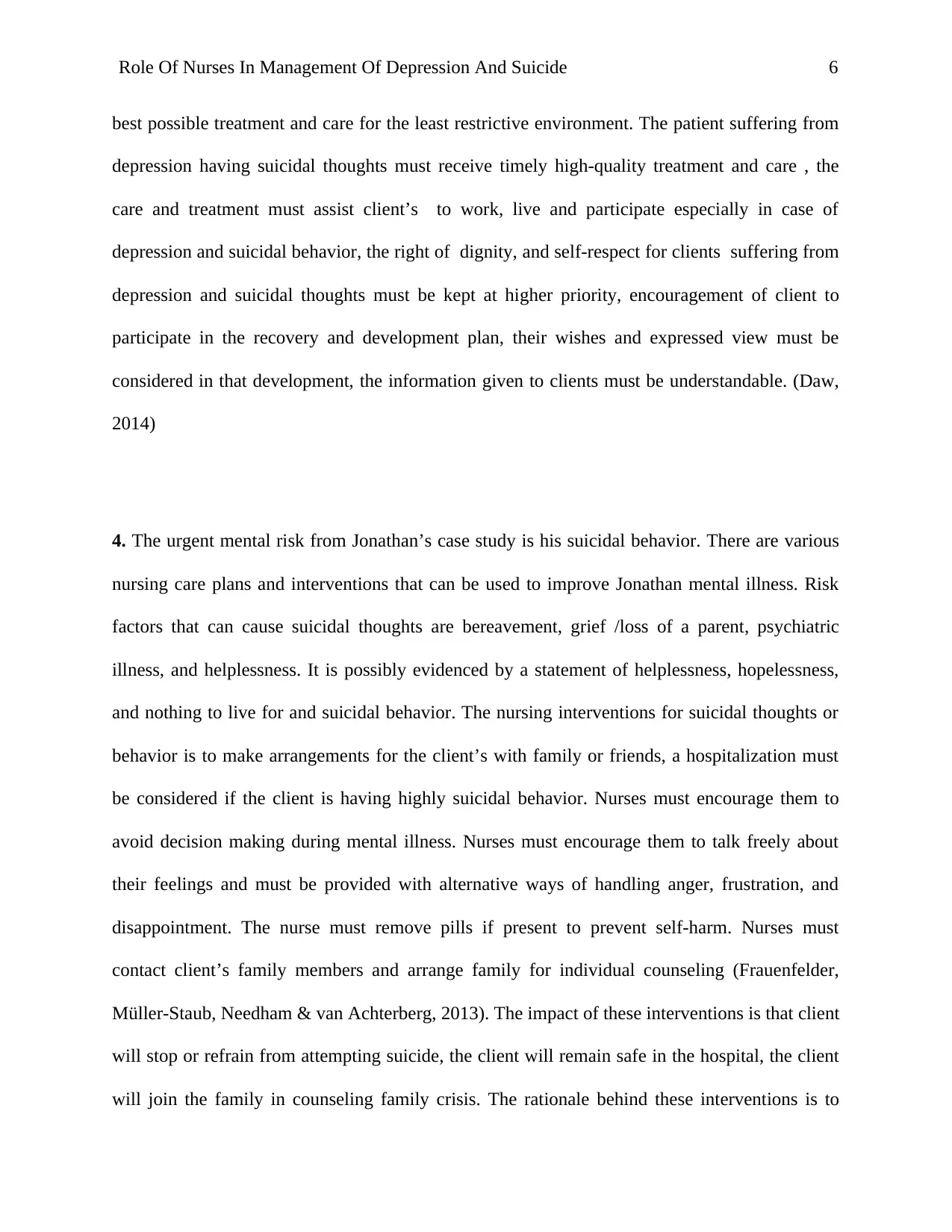
Role Of Nurses In Management Of Depression And Suicide 6
best possible treatment and care for the least restrictive environment. The patient suffering from
depression having suicidal thoughts must receive timely high-quality treatment and care , the
care and treatment must assist client’s to work, live and participate especially in case of
depression and suicidal behavior, the right of dignity, and self-respect for clients suffering from
depression and suicidal thoughts must be kept at higher priority, encouragement of client to
participate in the recovery and development plan, their wishes and expressed view must be
considered in that development, the information given to clients must be understandable. (Daw,
2014)
4. The urgent mental risk from Jonathan’s case study is his suicidal behavior. There are various
nursing care plans and interventions that can be used to improve Jonathan mental illness. Risk
factors that can cause suicidal thoughts are bereavement, grief /loss of a parent, psychiatric
illness, and helplessness. It is possibly evidenced by a statement of helplessness, hopelessness,
and nothing to live for and suicidal behavior. The nursing interventions for suicidal thoughts or
behavior is to make arrangements for the client’s with family or friends, a hospitalization must
be considered if the client is having highly suicidal behavior. Nurses must encourage them to
avoid decision making during mental illness. Nurses must encourage them to talk freely about
their feelings and must be provided with alternative ways of handling anger, frustration, and
disappointment. The nurse must remove pills if present to prevent self-harm. Nurses must
contact client’s family members and arrange family for individual counseling (Frauenfelder,
Müller-Staub, Needham & van Achterberg, 2013). The impact of these interventions is that client
will stop or refrain from attempting suicide, the client will remain safe in the hospital, the client
will join the family in counseling family crisis. The rationale behind these interventions is to
best possible treatment and care for the least restrictive environment. The patient suffering from
depression having suicidal thoughts must receive timely high-quality treatment and care , the
care and treatment must assist client’s to work, live and participate especially in case of
depression and suicidal behavior, the right of dignity, and self-respect for clients suffering from
depression and suicidal thoughts must be kept at higher priority, encouragement of client to
participate in the recovery and development plan, their wishes and expressed view must be
considered in that development, the information given to clients must be understandable. (Daw,
2014)
4. The urgent mental risk from Jonathan’s case study is his suicidal behavior. There are various
nursing care plans and interventions that can be used to improve Jonathan mental illness. Risk
factors that can cause suicidal thoughts are bereavement, grief /loss of a parent, psychiatric
illness, and helplessness. It is possibly evidenced by a statement of helplessness, hopelessness,
and nothing to live for and suicidal behavior. The nursing interventions for suicidal thoughts or
behavior is to make arrangements for the client’s with family or friends, a hospitalization must
be considered if the client is having highly suicidal behavior. Nurses must encourage them to
avoid decision making during mental illness. Nurses must encourage them to talk freely about
their feelings and must be provided with alternative ways of handling anger, frustration, and
disappointment. The nurse must remove pills if present to prevent self-harm. Nurses must
contact client’s family members and arrange family for individual counseling (Frauenfelder,
Müller-Staub, Needham & van Achterberg, 2013). The impact of these interventions is that client
will stop or refrain from attempting suicide, the client will remain safe in the hospital, the client
will join the family in counseling family crisis. The rationale behind these interventions is to
⊘ This is a preview!⊘
Do you want full access?
Subscribe today to unlock all pages.

Trusted by 1+ million students worldwide
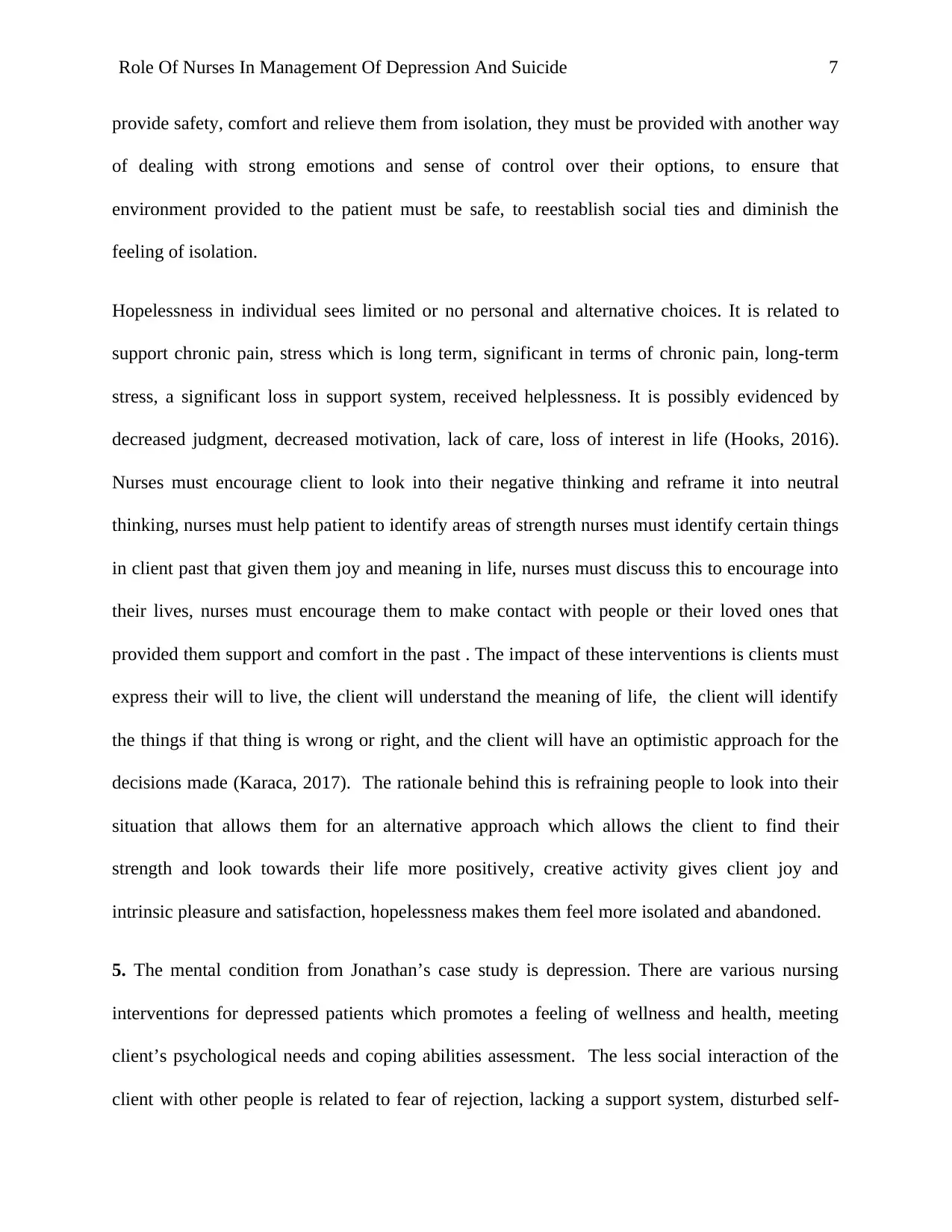
Role Of Nurses In Management Of Depression And Suicide 7
provide safety, comfort and relieve them from isolation, they must be provided with another way
of dealing with strong emotions and sense of control over their options, to ensure that
environment provided to the patient must be safe, to reestablish social ties and diminish the
feeling of isolation.
Hopelessness in individual sees limited or no personal and alternative choices. It is related to
support chronic pain, stress which is long term, significant in terms of chronic pain, long-term
stress, a significant loss in support system, received helplessness. It is possibly evidenced by
decreased judgment, decreased motivation, lack of care, loss of interest in life (Hooks, 2016).
Nurses must encourage client to look into their negative thinking and reframe it into neutral
thinking, nurses must help patient to identify areas of strength nurses must identify certain things
in client past that given them joy and meaning in life, nurses must discuss this to encourage into
their lives, nurses must encourage them to make contact with people or their loved ones that
provided them support and comfort in the past . The impact of these interventions is clients must
express their will to live, the client will understand the meaning of life, the client will identify
the things if that thing is wrong or right, and the client will have an optimistic approach for the
decisions made (Karaca, 2017). The rationale behind this is refraining people to look into their
situation that allows them for an alternative approach which allows the client to find their
strength and look towards their life more positively, creative activity gives client joy and
intrinsic pleasure and satisfaction, hopelessness makes them feel more isolated and abandoned.
5. The mental condition from Jonathan’s case study is depression. There are various nursing
interventions for depressed patients which promotes a feeling of wellness and health, meeting
client’s psychological needs and coping abilities assessment. The less social interaction of the
client with other people is related to fear of rejection, lacking a support system, disturbed self-
provide safety, comfort and relieve them from isolation, they must be provided with another way
of dealing with strong emotions and sense of control over their options, to ensure that
environment provided to the patient must be safe, to reestablish social ties and diminish the
feeling of isolation.
Hopelessness in individual sees limited or no personal and alternative choices. It is related to
support chronic pain, stress which is long term, significant in terms of chronic pain, long-term
stress, a significant loss in support system, received helplessness. It is possibly evidenced by
decreased judgment, decreased motivation, lack of care, loss of interest in life (Hooks, 2016).
Nurses must encourage client to look into their negative thinking and reframe it into neutral
thinking, nurses must help patient to identify areas of strength nurses must identify certain things
in client past that given them joy and meaning in life, nurses must discuss this to encourage into
their lives, nurses must encourage them to make contact with people or their loved ones that
provided them support and comfort in the past . The impact of these interventions is clients must
express their will to live, the client will understand the meaning of life, the client will identify
the things if that thing is wrong or right, and the client will have an optimistic approach for the
decisions made (Karaca, 2017). The rationale behind this is refraining people to look into their
situation that allows them for an alternative approach which allows the client to find their
strength and look towards their life more positively, creative activity gives client joy and
intrinsic pleasure and satisfaction, hopelessness makes them feel more isolated and abandoned.
5. The mental condition from Jonathan’s case study is depression. There are various nursing
interventions for depressed patients which promotes a feeling of wellness and health, meeting
client’s psychological needs and coping abilities assessment. The less social interaction of the
client with other people is related to fear of rejection, lacking a support system, disturbed self-
Paraphrase This Document
Need a fresh take? Get an instant paraphrase of this document with our AI Paraphraser
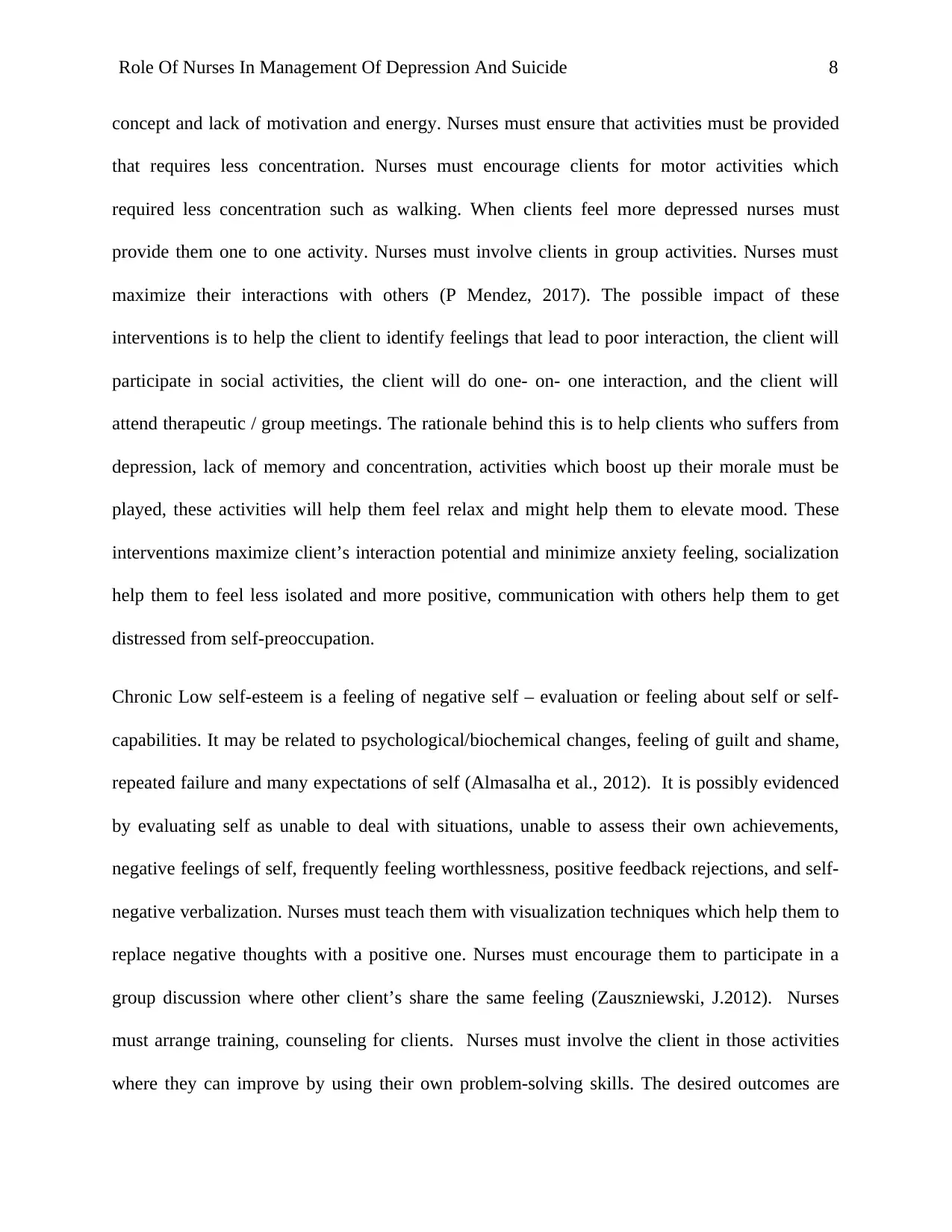
Role Of Nurses In Management Of Depression And Suicide 8
concept and lack of motivation and energy. Nurses must ensure that activities must be provided
that requires less concentration. Nurses must encourage clients for motor activities which
required less concentration such as walking. When clients feel more depressed nurses must
provide them one to one activity. Nurses must involve clients in group activities. Nurses must
maximize their interactions with others (P Mendez, 2017). The possible impact of these
interventions is to help the client to identify feelings that lead to poor interaction, the client will
participate in social activities, the client will do one- on- one interaction, and the client will
attend therapeutic / group meetings. The rationale behind this is to help clients who suffers from
depression, lack of memory and concentration, activities which boost up their morale must be
played, these activities will help them feel relax and might help them to elevate mood. These
interventions maximize client’s interaction potential and minimize anxiety feeling, socialization
help them to feel less isolated and more positive, communication with others help them to get
distressed from self-preoccupation.
Chronic Low self-esteem is a feeling of negative self – evaluation or feeling about self or self-
capabilities. It may be related to psychological/biochemical changes, feeling of guilt and shame,
repeated failure and many expectations of self (Almasalha et al., 2012). It is possibly evidenced
by evaluating self as unable to deal with situations, unable to assess their own achievements,
negative feelings of self, frequently feeling worthlessness, positive feedback rejections, and self-
negative verbalization. Nurses must teach them with visualization techniques which help them to
replace negative thoughts with a positive one. Nurses must encourage them to participate in a
group discussion where other client’s share the same feeling (Zauszniewski, J.2012). Nurses
must arrange training, counseling for clients. Nurses must involve the client in those activities
where they can improve by using their own problem-solving skills. The desired outcomes are
concept and lack of motivation and energy. Nurses must ensure that activities must be provided
that requires less concentration. Nurses must encourage clients for motor activities which
required less concentration such as walking. When clients feel more depressed nurses must
provide them one to one activity. Nurses must involve clients in group activities. Nurses must
maximize their interactions with others (P Mendez, 2017). The possible impact of these
interventions is to help the client to identify feelings that lead to poor interaction, the client will
participate in social activities, the client will do one- on- one interaction, and the client will
attend therapeutic / group meetings. The rationale behind this is to help clients who suffers from
depression, lack of memory and concentration, activities which boost up their morale must be
played, these activities will help them feel relax and might help them to elevate mood. These
interventions maximize client’s interaction potential and minimize anxiety feeling, socialization
help them to feel less isolated and more positive, communication with others help them to get
distressed from self-preoccupation.
Chronic Low self-esteem is a feeling of negative self – evaluation or feeling about self or self-
capabilities. It may be related to psychological/biochemical changes, feeling of guilt and shame,
repeated failure and many expectations of self (Almasalha et al., 2012). It is possibly evidenced
by evaluating self as unable to deal with situations, unable to assess their own achievements,
negative feelings of self, frequently feeling worthlessness, positive feedback rejections, and self-
negative verbalization. Nurses must teach them with visualization techniques which help them to
replace negative thoughts with a positive one. Nurses must encourage them to participate in a
group discussion where other client’s share the same feeling (Zauszniewski, J.2012). Nurses
must arrange training, counseling for clients. Nurses must involve the client in those activities
where they can improve by using their own problem-solving skills. The desired outcomes are
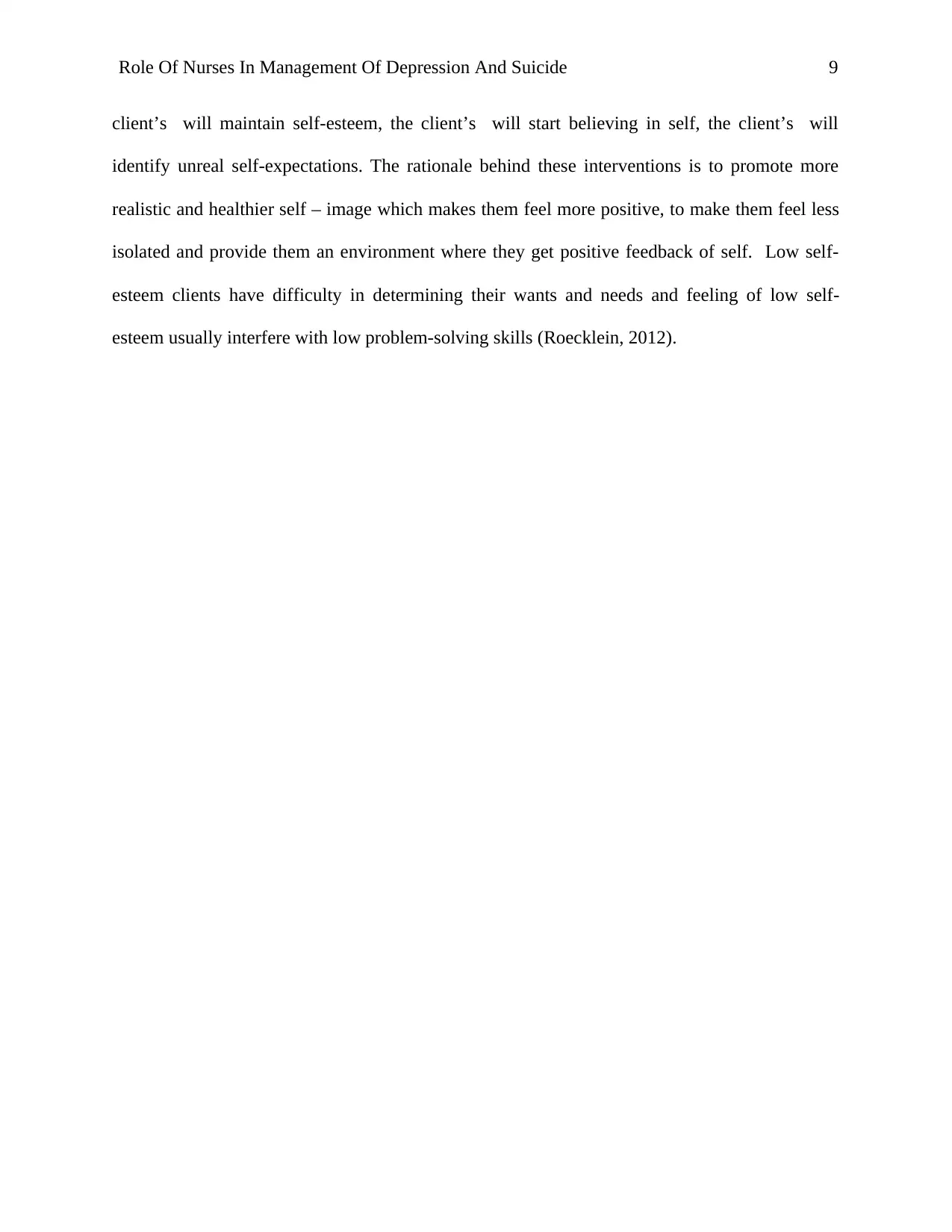
Role Of Nurses In Management Of Depression And Suicide 9
client’s will maintain self-esteem, the client’s will start believing in self, the client’s will
identify unreal self-expectations. The rationale behind these interventions is to promote more
realistic and healthier self – image which makes them feel more positive, to make them feel less
isolated and provide them an environment where they get positive feedback of self. Low self-
esteem clients have difficulty in determining their wants and needs and feeling of low self-
esteem usually interfere with low problem-solving skills (Roecklein, 2012).
client’s will maintain self-esteem, the client’s will start believing in self, the client’s will
identify unreal self-expectations. The rationale behind these interventions is to promote more
realistic and healthier self – image which makes them feel more positive, to make them feel less
isolated and provide them an environment where they get positive feedback of self. Low self-
esteem clients have difficulty in determining their wants and needs and feeling of low self-
esteem usually interfere with low problem-solving skills (Roecklein, 2012).
⊘ This is a preview!⊘
Do you want full access?
Subscribe today to unlock all pages.

Trusted by 1+ million students worldwide
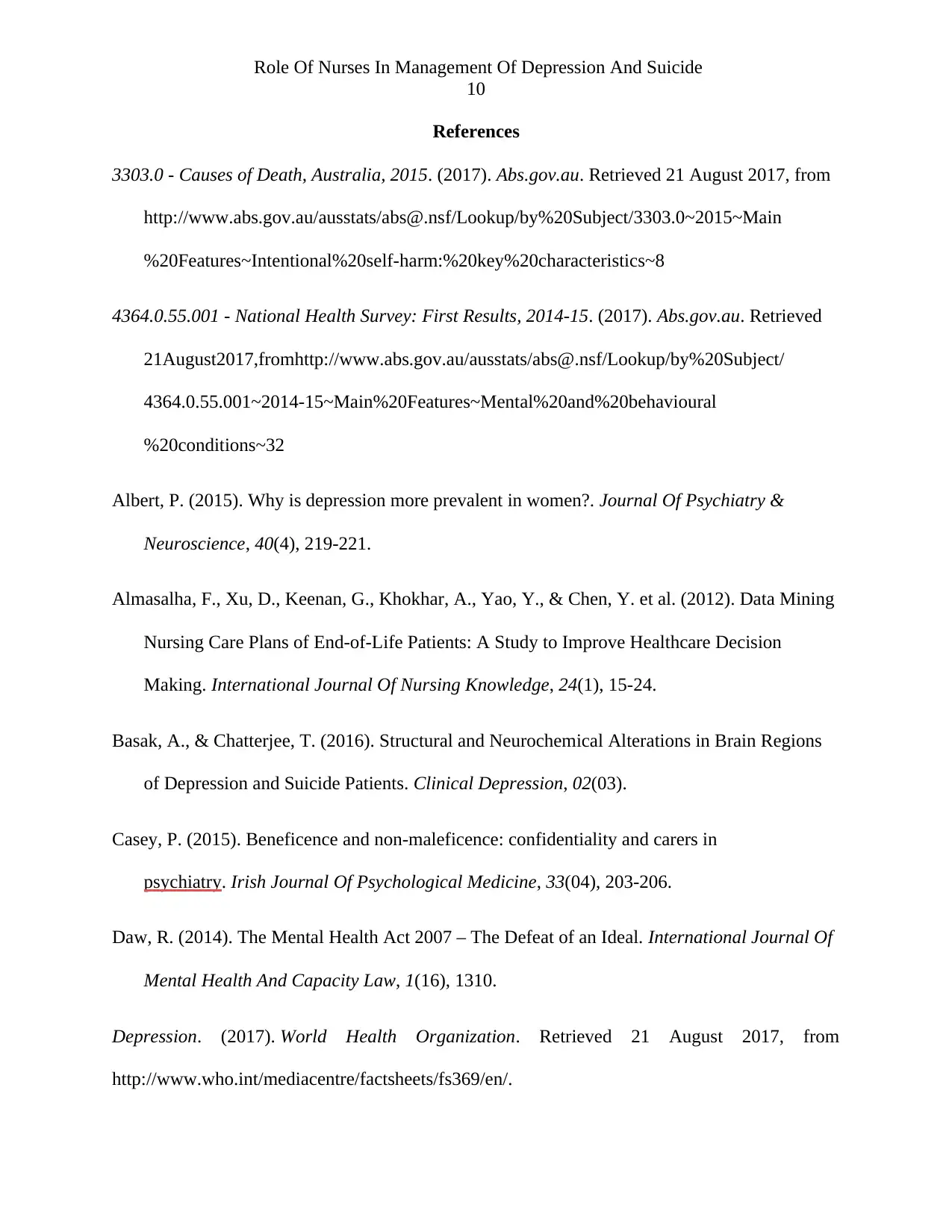
Role Of Nurses In Management Of Depression And Suicide
10
References
3303.0 - Causes of Death, Australia, 2015. (2017). Abs.gov.au. Retrieved 21 August 2017, from
http://www.abs.gov.au/ausstats/abs@.nsf/Lookup/by%20Subject/3303.0~2015~Main
%20Features~Intentional%20self-harm:%20key%20characteristics~8
4364.0.55.001 - National Health Survey: First Results, 2014-15. (2017). Abs.gov.au. Retrieved
21August2017,fromhttp://www.abs.gov.au/ausstats/abs@.nsf/Lookup/by%20Subject/
4364.0.55.001~2014-15~Main%20Features~Mental%20and%20behavioural
%20conditions~32
Albert, P. (2015). Why is depression more prevalent in women?. Journal Of Psychiatry &
Neuroscience, 40(4), 219-221.
Almasalha, F., Xu, D., Keenan, G., Khokhar, A., Yao, Y., & Chen, Y. et al. (2012). Data Mining
Nursing Care Plans of End-of-Life Patients: A Study to Improve Healthcare Decision
Making. International Journal Of Nursing Knowledge, 24(1), 15-24.
Basak, A., & Chatterjee, T. (2016). Structural and Neurochemical Alterations in Brain Regions
of Depression and Suicide Patients. Clinical Depression, 02(03).
Casey, P. (2015). Beneficence and non-maleficence: confidentiality and carers in
psychiatry. Irish Journal Of Psychological Medicine, 33(04), 203-206.
Daw, R. (2014). The Mental Health Act 2007 – The Defeat of an Ideal. International Journal Of
Mental Health And Capacity Law, 1(16), 1310.
Depression. (2017). World Health Organization. Retrieved 21 August 2017, from
http://www.who.int/mediacentre/factsheets/fs369/en/.
10
References
3303.0 - Causes of Death, Australia, 2015. (2017). Abs.gov.au. Retrieved 21 August 2017, from
http://www.abs.gov.au/ausstats/abs@.nsf/Lookup/by%20Subject/3303.0~2015~Main
%20Features~Intentional%20self-harm:%20key%20characteristics~8
4364.0.55.001 - National Health Survey: First Results, 2014-15. (2017). Abs.gov.au. Retrieved
21August2017,fromhttp://www.abs.gov.au/ausstats/abs@.nsf/Lookup/by%20Subject/
4364.0.55.001~2014-15~Main%20Features~Mental%20and%20behavioural
%20conditions~32
Albert, P. (2015). Why is depression more prevalent in women?. Journal Of Psychiatry &
Neuroscience, 40(4), 219-221.
Almasalha, F., Xu, D., Keenan, G., Khokhar, A., Yao, Y., & Chen, Y. et al. (2012). Data Mining
Nursing Care Plans of End-of-Life Patients: A Study to Improve Healthcare Decision
Making. International Journal Of Nursing Knowledge, 24(1), 15-24.
Basak, A., & Chatterjee, T. (2016). Structural and Neurochemical Alterations in Brain Regions
of Depression and Suicide Patients. Clinical Depression, 02(03).
Casey, P. (2015). Beneficence and non-maleficence: confidentiality and carers in
psychiatry. Irish Journal Of Psychological Medicine, 33(04), 203-206.
Daw, R. (2014). The Mental Health Act 2007 – The Defeat of an Ideal. International Journal Of
Mental Health And Capacity Law, 1(16), 1310.
Depression. (2017). World Health Organization. Retrieved 21 August 2017, from
http://www.who.int/mediacentre/factsheets/fs369/en/.
Paraphrase This Document
Need a fresh take? Get an instant paraphrase of this document with our AI Paraphraser
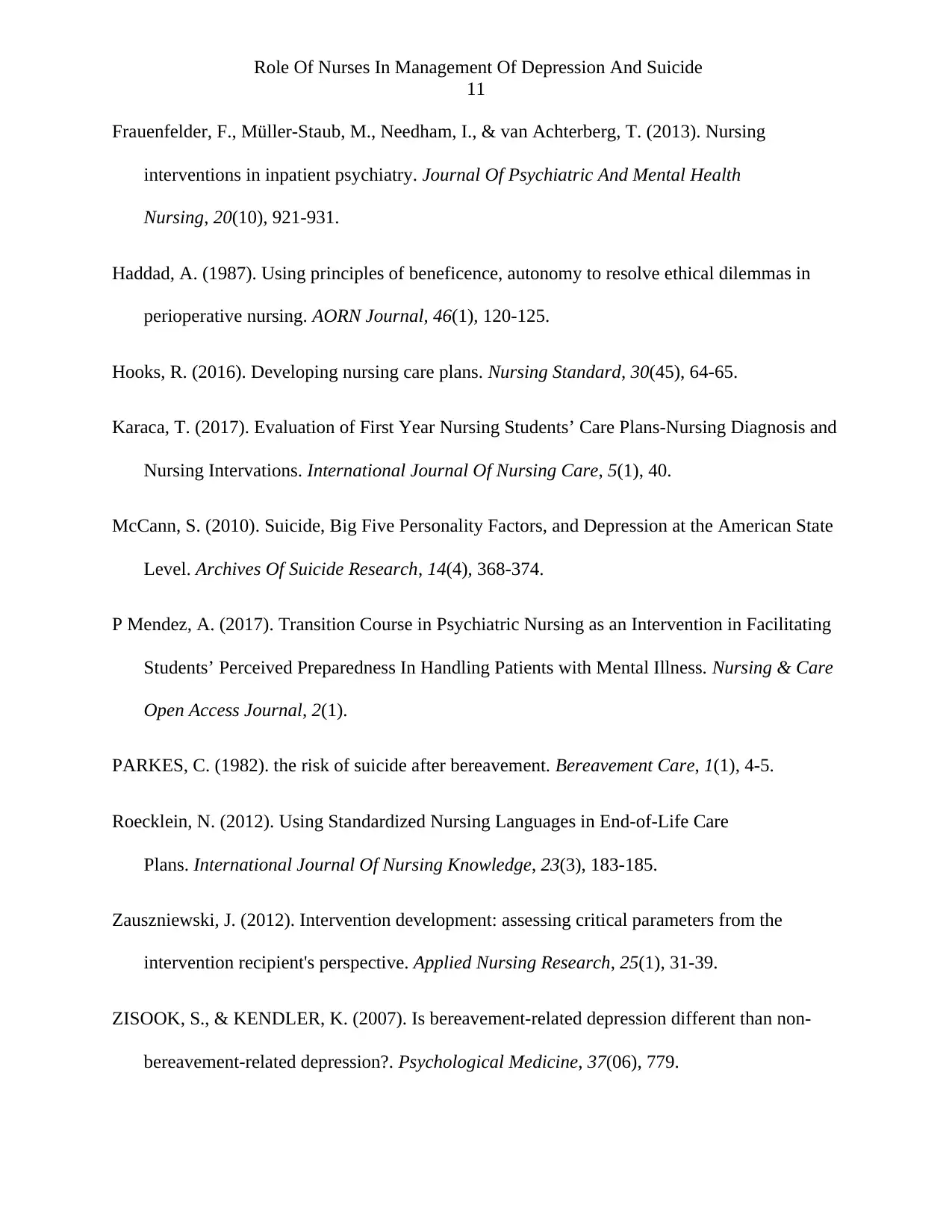
Role Of Nurses In Management Of Depression And Suicide
11
Frauenfelder, F., Müller-Staub, M., Needham, I., & van Achterberg, T. (2013). Nursing
interventions in inpatient psychiatry. Journal Of Psychiatric And Mental Health
Nursing, 20(10), 921-931.
Haddad, A. (1987). Using principles of beneficence, autonomy to resolve ethical dilemmas in
perioperative nursing. AORN Journal, 46(1), 120-125.
Hooks, R. (2016). Developing nursing care plans. Nursing Standard, 30(45), 64-65.
Karaca, T. (2017). Evaluation of First Year Nursing Students’ Care Plans-Nursing Diagnosis and
Nursing Intervations. International Journal Of Nursing Care, 5(1), 40.
McCann, S. (2010). Suicide, Big Five Personality Factors, and Depression at the American State
Level. Archives Of Suicide Research, 14(4), 368-374.
P Mendez, A. (2017). Transition Course in Psychiatric Nursing as an Intervention in Facilitating
Students’ Perceived Preparedness In Handling Patients with Mental Illness. Nursing & Care
Open Access Journal, 2(1).
PARKES, C. (1982). the risk of suicide after bereavement. Bereavement Care, 1(1), 4-5.
Roecklein, N. (2012). Using Standardized Nursing Languages in End-of-Life Care
Plans. International Journal Of Nursing Knowledge, 23(3), 183-185.
Zauszniewski, J. (2012). Intervention development: assessing critical parameters from the
intervention recipient's perspective. Applied Nursing Research, 25(1), 31-39.
ZISOOK, S., & KENDLER, K. (2007). Is bereavement-related depression different than non-
bereavement-related depression?. Psychological Medicine, 37(06), 779.
11
Frauenfelder, F., Müller-Staub, M., Needham, I., & van Achterberg, T. (2013). Nursing
interventions in inpatient psychiatry. Journal Of Psychiatric And Mental Health
Nursing, 20(10), 921-931.
Haddad, A. (1987). Using principles of beneficence, autonomy to resolve ethical dilemmas in
perioperative nursing. AORN Journal, 46(1), 120-125.
Hooks, R. (2016). Developing nursing care plans. Nursing Standard, 30(45), 64-65.
Karaca, T. (2017). Evaluation of First Year Nursing Students’ Care Plans-Nursing Diagnosis and
Nursing Intervations. International Journal Of Nursing Care, 5(1), 40.
McCann, S. (2010). Suicide, Big Five Personality Factors, and Depression at the American State
Level. Archives Of Suicide Research, 14(4), 368-374.
P Mendez, A. (2017). Transition Course in Psychiatric Nursing as an Intervention in Facilitating
Students’ Perceived Preparedness In Handling Patients with Mental Illness. Nursing & Care
Open Access Journal, 2(1).
PARKES, C. (1982). the risk of suicide after bereavement. Bereavement Care, 1(1), 4-5.
Roecklein, N. (2012). Using Standardized Nursing Languages in End-of-Life Care
Plans. International Journal Of Nursing Knowledge, 23(3), 183-185.
Zauszniewski, J. (2012). Intervention development: assessing critical parameters from the
intervention recipient's perspective. Applied Nursing Research, 25(1), 31-39.
ZISOOK, S., & KENDLER, K. (2007). Is bereavement-related depression different than non-
bereavement-related depression?. Psychological Medicine, 37(06), 779.

Role Of Nurses In Management Of Depression And Suicide
12
12
⊘ This is a preview!⊘
Do you want full access?
Subscribe today to unlock all pages.

Trusted by 1+ million students worldwide
1 out of 12
Related Documents
Your All-in-One AI-Powered Toolkit for Academic Success.
+13062052269
info@desklib.com
Available 24*7 on WhatsApp / Email
![[object Object]](/_next/static/media/star-bottom.7253800d.svg)
Unlock your academic potential
Copyright © 2020–2025 A2Z Services. All Rights Reserved. Developed and managed by ZUCOL.





